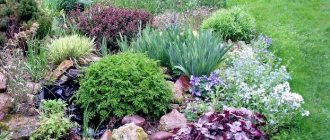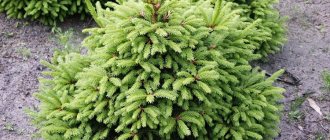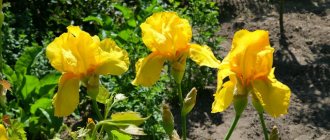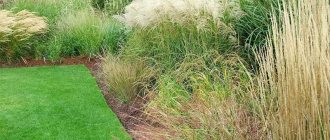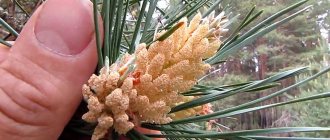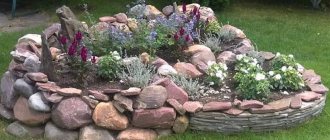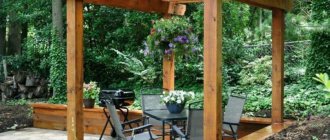Peonies are very ancient inhabitants of gardens. And although every plant is unique, the peony is special. They are deservedly loved by designers, breeders and gardeners all over the world. In Asian countries, the flower is considered a talisman for good luck and prosperity, and healers use a tincture from it for a dozen diseases. The flowering time is June, then the flower becomes the real king of the garden. Peony is not only incredibly beautiful, but also completely unpretentious. Even a novice gardener can grow it.
It is impossible to resist the variety of forms, varieties and aromas of this wonderful plant. By the number of stems you can determine the age of the blooming miracle. The seven-year-old plant has more than forty stems. The leaves are large and complex. In different varieties they can be wide or narrow, and there are even needle-shaped ones. The diameter of the flowers also depends on the species diversity, ranging from 12 to 27 cm. First, the flowers bloom in the center of the bush, then the side buds. A complex rhizome has three types of roots: storage, suction and adventitious.
Application in landscape design
Due to its beauty and lushness of the bush, peony is planted near bodies of water. During flowering, reflected in the water, it turns the landscape into a painting by Flemish artists. The incredible variety of shades and perfection of shapes significantly distinguish peony from other flower crops. The bushes are planted quite closely to each other. Blooming flowers merge into one perfect picture. By using varieties that change color towards the end of flowering, you can add variety to your garden. This phenomenon does not allow the garden to acquire a bored look, and the reflection of flowers in the water fascinates and touches.
A peony at the entrance to a garden, house or near a gazebo creates a romantic mood. But one color, even the brightest, will not bring the same aesthetic pleasure as a skillfully selected tandem or ensemble. Welcoming guests in combination with a contrasting color scheme (warm and cold), peony looks even more delicate and refined. You can use seasonal decorative blocks. Then the emphasis on flowering moves around the estate. The garden seems to live its own life.
And although the monochrome composition is always relevant, and the large size of the color spot is actively used by landscape designers, multi-color also does not lose its position. The diversity of the color palette helps to plant several shades of peony together, then the flower garden does not turn into one bright spot, but serves as a color stretcher. Then you can consider all its nuances and tones. This makes it possible to appreciate the depth and richness of color.
Because of its beauty and picturesqueness, peony often outshines its neighbors and many gardeners are wary of placing them in mixborders. The solution in this case is a flower garden group. This option for designing a flower bed involves planting several (mostly 3-5) perennials, blooming one after another. It is important that the plants retain their decorative properties after flowering and do not spoil the presentability of the entire group. This, in its own way, is spectacular in that quantity when the peony can show itself in all its glory. It will look more memorable.
Low-growing, drought-resistant varieties look good in rock gardens. Thin-leaved peony and Crimean peony beautifully frame the stones and fit into the overall style of the Japanese stone flowerbed.
Decorate garden paths with a composition of peony and primroses (crocus, tulips, galanthus, reticulated iris, daffodils and others). It is important to create continuity of flowering here. By skillfully selecting plants, all paths to the garden or house will beautifully frame and divide the area, decorating it with flowering from April to November. Astilbe, lilies, godetia, a variety of petunias, and zinnia will help with this.
By giving preference to the tree peony, you can contemplate the wonderful contrast against the background of golden and crimson leaves in the fall. The dark leaves have a purple glow. Do not forget about the characteristics of the herbaceous peony; after precipitation, the bush disintegrates and may lose its decorative effect. To do this, gardeners install special metal structures to support the perennial. These can be special shapes, in the form of a butterfly, or geometric shapes.
The narrow shape of the leaves, traditional for a Japanese-style garden, is used to decorate a rock garden. Harmony and naturalness, as if in the lap of nature, are emphasized by dwarf representatives of conifers (juniper, pine, thuja). This helps create an interesting, bright and rich look.
Win-win combinations for flower beds trio
The absolute favorite among the trio is the combination “peony + delphinium + mantle”, striking in contrasts and seemingly illustrating all the principles of selecting plants for flower beds from only three types of crops. A low cuff with its inimitable openwork and bright optimistic color, an impressive and classic, but no less beautiful massive peony with its giant inflorescences and tall candles of openwork delphinium, soaring against the background of partners and literally raising the flower garden to new heights - what could be more beautiful? .. Moreover, the choice of varieties of both delphinium and peony allows you to endlessly change this classic trio and create unique variations. But if you want a more obvious variety, then three alternative trios with the participation of milky peony will suit you:
- peony + magnificent geranium + mantle;
- peony + snow-white lily + blood-red geranium;
- peony + musky mallow + oak sage.
A classic, hardy perennial, which for many has become a symbol of a country-style garden, captivating with its watercolor palette, the beauty of its shape and leaves, and elongated inflorescences with a rustic, but not rustic charm - multileaf lupine. It can be included in flower trios in almost any combination, since it contrasts perfectly with both the most modern and original, and the most modest cultures. An excellent flower garden, for example, will be created if you add cornflower to the classic combination of “lupine + aquilegia,” creating a pastoral picture in the spirit of the best examples of landscape design. But there are other variations of flowering trios with the participation of many-sided lupins:
- lupine + bearded or Siberian iris + decorative onion;
- lupine + yarrow + meadow chamomile;
- lupine + paniculata phlox + veronica longifolia;
- lupine + paniculata phlox + Turkish poppy.
Lovers of bright colors and garden classics will certainly appreciate the combination of dazzling Turkish poppies, or any much more modest type of these amazing plants, with the watercolor beauty of bearded irises. But both of them will not be able to decorate the garden throughout the active season and will quickly leave the garden scene. It is easy to compensate for their unattractive greenery after flowering if you add oregano - the spicy common oregano - as a third companion. The openwork ripples of this plant, which looks great before, during, and after flowering, and even when the first snow falls, will delight the eye and emphasize the beauty of the main soloists. The trio “poppy + irises + oregano” also has alternatives:
- poppy + bearded irises + sage (from common to oak grove);
- poppy + bearded irises + mantle;
- poppy + bearded irises + garden geraniums;
- poppy + bearded irises + catnip;
- poppy + bearded irises + Byzantine chist.
Flower garden of peonies, lupins and irises.
© Susanne Holland However, in a trio with two shocking flowering stars, you can choose any other plant from among the universal partners that retain their beauty until late autumn to suit your taste.
Gardens in a natural style provide special opportunities for using such flower trios, because small groups of plants can be scattered literally throughout the entire area of the garden, adding improvisation, lightness, and charm. Natural, wild beauty is inherent in the lush combination of the charming yellow daylily, lush cuff and bright, but so wild-looking blue cyanosis. This trio can be used not only for a classic flower garden, but also for decorating the shore of a reservoir in a natural style.
Ensembles with the participation of a not very popular, but very spectacular large perennial, whose leaves resemble maple ones - Kirengeshoma palmate, radiate even more the harmony of the natural beauty of nature. Drops of creamy-yellowish bell-shaped flowers rise above the luxurious leaves in late summer, allowing you to select earlier-blooming plants as partners. True, when selecting plants for flower beds, it is worth considering that Kirengeshoma prefers secluded, shaded places in the garden. Excellent trios for decorating compositions in the shade can be obtained from a combination:
- Kirengeshoma + Japanese anemone + Chinese astilbe;
- Kirengeshoma + ferns (ostrich, shield grass, etc.) + hosta;
- Kirengeshoma + black cohosh + tiarella cordifolia.
The unusual combination of different shades of the red part of the spectrum in aster, echinacea and crocosmia cannot be called anything other than extravagant. The original shape of the inflorescences, which are not similar to each other despite the same principle of structure and the completely different character of these perennials, attracts the eye in both modern and country gardens. The flaming fiery crocosmia with its graceful inflorescences and linear leaves in a thick turf, the austere and “invulnerable” Echinacea purpurea with its carmine-red baskets, with a convex center and the unpretentious lilac-lilac aster chamomile, which looks like a blooming pillow, together create a complete ensemble with a complex play of textures and colors.
Lovers of calm colors and blue color will certainly like another modern combination of the luxurious Echinops Echinops with its bold, ball-like inflorescences, modern, bright, and at the same time surprisingly versatile Veronica with its blue spikelets of inflorescences and the inimitably lacy geranium, magnificent with its cup-shaped, large and shining flowers of a lilac-blue hue. It is very difficult to call such a trio simple or out-of-date, because it combines such daring shapes and colors that even in the most austere high-tech garden this ensemble will not get lost.
Flower garden of sage, irises and violets. © Susanne Holland
Combination with other plants
It is difficult to combine the yellow-flowered representative with other crops. This shade is not included in the generally accepted range; it is self-sufficient. Such varieties are planted as tapeworms. This is an excellent combination with a green lawn or coniferous plants. In mixborders, peony is combined with delphinium, helenium, and perennial asters. Double varieties with their heavy stems support their neighbors.
Luxurious peonies harmonize perfectly with white decorative onions. Its heads are not buried in the bright splendor of the “king of the garden”, but act as a contrast and look quite touching. Blood red heuchera and carnation make wonderful company with white and coral peonies. Barberry bushes and dark greenery gracefully shade and highlight the delicate pink buds.
Irises, poppies, honeysuckle, lilies, and bells set accents and create an appropriate contrast with peony. Tall and dwarf plants with small inflorescences are acceptable in compositions. Deciduous decorative plants are often planted next to the peony; they play the role of a kind of background. Juniper bushes and tall trees also become a backdrop for bright and rich peony flowers.
When combining peonies in one composition, do not forget about the need for a decent distance between them, for the convenience of loosening the soil. What is so necessary for flowering perennials.
The “King of the Garden” is placed in groups of three bushes at the corners of the lawn, and its perimeter is planted with bergenia, primrose, daisies, mantle and other low-growing representatives of the flora. Foxglove and delphinium are used as accents to soften the transition.
Compositional approaches
The composition in the arrangement of a flower bed plays an important role.
- Tall coniferous trees will help highlight the tenderness of pink and white-pink peonies. The flowers will look great against the backdrop of juniper thickets.
- Peonies are often the center of a flower arrangement. It is logical to surround them with low-growing flowers: primroses, daisies, bergenia. You can make several tiers.
- If the flowerbed is large, a good idea would be to plant three peony bushes in its corners, filling the space between them with a mantle or bergenia. In this case, vertical accents can be placed with the help of foxglove and delphinium.
Experienced flower growers do not advise planting small flowers directly between peony bushes, as this will make them difficult to care for.
Landing and travel
The “king of the garden” is planted or replanted in spring or autumn. The spring period is very short, you need to have time to carry out all the work before increased growth. This is why amateur gardeners do everything in the fall. The plant loves loamy soil, which has enough organic fertilizers. If there is a possibility of storm water and melt water entering, then drainage is vital. The depth of the hole is half a meter deep and the same width.
The plant is unpretentious, but for annual abundant flowering it needs good care. It happens that the peony does not bloom. There are several reasons for this. The main problem may be in the wrong place for planting and in the planting itself. The peony rhizome should be sufficiently buried in the ground. Such a flower can be identified even without flowering; it has a sickly appearance. Complete pruning after flowering is strictly prohibited. This way the plant is deprived of developing buds. If the procedure is carried out correctly, two or three leaves and the lower part of the peduncle remain. They are pruned at the root only in the fall. For the winter, the plant is well protected from the cold.
Fungal diseases pose a danger to the plant. Most often they appear due to a lack of minerals and weakening of the peony. This occurs from lack of care and improper early pruning. Regular watering and loosening the soil of young plants, as well as watering older bushes, in most cases, prevents insect pests from affecting the peony.
Where to plant peonies in a summer cottage and how to do it correctly
Lush flowering and a beautiful appearance of the bush depend on the choice of planting site: peonies love sunny places, protected from the wind, but with good air circulation. Plants do not tolerate shade well, wither, and some varieties stop blooming.
Important! It is not recommended to plant peonies close to buildings; an excess of solar heat in hot summers can destroy the plants. The distance from the walls of the house and the solid fence should be at least one and a half meters.
Peonies prefer loose loamy soils rich in organic matter with a neutral or slightly alkaline reaction. In low-lying areas with a high groundwater level (more than 70 cm), it is necessary to provide good drainage so that the root system of plants does not rot.
The optimal time for planting plants in open ground is from mid-August to mid-September.
Attention! In group plantings, peonies in the garden are placed at a distance of a meter and a half from each other; when combined with other garden flora, the characteristics of the root system and growth of companion plants are taken into account.
Planting pattern:
- Dig a hole at least 60 cm wide and high.
- A third of the hole is filled with drainage made from pebbles, brick chips, crushed stone, and sand.
- A layer of enriched soil is poured over the drainage to the top (the top layer of soil from the pit is thoroughly mixed with sand and compost in a ratio of 1:1:2).
- Leave the hole for one to two weeks so that the earth has time to settle.
- The rhizome is carefully placed in the hole and lightly crushed. In herbaceous varieties, the growth point is deepened by 3–4 cm (if deepened, the bush grows strongly, but does not bloom for a long time), tree-like and Ito hybrids are planted deeply, covering the root collar with a layer of soil of 10–15 cm.
- Water well and mulch with humus or leaf soil.
Types of mixborders
Mixborders come in single-sided and double-sided varieties . In one-sided flower beds, the tallest plants are placed in the background, and closer to the viewpoint their height decreases. They are located along garden paths, fences, and retaining walls. Also, a one-sided mixborder can be created near the wall of a house or other building, on a steep slope, on the border of the garden.
When a flower garden is laid out in an open space, visible from several sides, the tallest plants are placed along its median line. Then, as you approach the edges, the height of the plantings decreases according to the cascade principle.
Mixborders also differ in content. They may contain perennials, herbs, low-growing trees, shrubs, and annual flowers. In most cases, preference is given to perennial plants that form the basis of the flower garden.
Types of mixborders by vegetation type:
- English. They are distinguished by their restraint in execution; the basis is shrubs with elongated leaves (willow, nutcracker) and beautifully flowering perennials, for example, peonies.
In English mixborders, it is appropriate to combine majestic roses or hydrangeas with daisies and violas that do not claim primacy; - Lugovoy. Made from herbs and annual flowers such as chamomile, snapdragon, zinnia, flax, poppy. Very similar to the Moorish meadow. It differs from it in the tiered arrangement of plants and the elongation of the flower bed;
- Country estate style. The use of shrubs and flowers traditional for rural areas is typical: viburnum, mallow, tagetes, cornflower, nasturtium, sedum. Used to create a homely atmosphere. In a village mixborder, it is acceptable to use garden berries: currants, gooseberries, serviceberry;
- Garden. It is created from garden crops, ornamental, spicy and medicinal herbs. Tall Jerusalem artichoke or sunflowers are planted in the background, and other plants are placed in front of them: different types of cabbage (kohlrabi, broccoli), curly parsley, fire beans, mint, lemon balm, thyme. Such a mixborder can be arranged in a country house, in the courtyard of a private house. Very relevant for small garden plots.
Preparing peonies for the winter season
Regardless of the type and climatic conditions, peonies, aged from planting to 3 years, need shelter for the winter. More mature bushes do not need to be covered, but simply mulched with dry peat or humus.
They begin to build a shelter for herbaceous varieties as soon as a stable sub-zero temperature is established. The cut shoots are covered with loose soil or peat with a layer of 10 cm.
In the northern regions, the mulch layer is increased to 20 cm. The resulting mound is additionally covered with spruce branches, straw or sawdust. In spring, the shelter is removed.
Tree peonies are covered more carefully. First, the stems are tied together using fabric twine. Low young bushes are covered with spruce branches, burlap or covering material. On top, to protect the plant from wind and snow, a hut made of spruce branches or branches of fruit trees after pruning is installed.
Tall bushes are also tied. A wood frame is installed around the plant. The fence must match the size of the bush or be slightly higher than it. The space between the frame and the plant is covered with dry leaves.
Features of creating a mixborder: tips for beginners
To get a beautiful mixborder, it is not enough to know only the basic principles of its structure (elongation and multi-tieredness). There are many more secrets that help create an impeccable “flower garden of free outlines”.
Plants that do not get along with each other, that is, between which antagonistic relationships arise, should not be planted inside the flower garden.
For example, roses and peonies, plants from the buttercup family and bulbous plants, tulips and lilies can become bad neighbors. Almost no vegetation gets along with dahlias, so they should be especially carefully included in the mixborder.
If any species has a rapidly growing “invasive” root system that suppresses its neighbors, it is better not to use it. But in the case when you really want to have this particular species in a mixborder, you should isolate a separate plot of land for it, fencing it with border tape.
Border tape
It is difficult to provide favorable conditions for the growth of each plant when their requirements for watering and soil composition are radically different. It is better for beginning flower growers to choose vegetation with the same requirements for soil moisture, degree of illumination, and acid-base balance of the soil.
Selection rules
The only rule for choosing partners for a peony is that the plant must have similar requirements for growth conditions in combination with flowers that are significantly smaller than those of the peony. But the color scheme of a candidate partner can vary from shades that are lighter in relation to the color of the peony flowers to the darkest variations of purple and burgundy.
A significant drawback of peonies is their “attachment” to the beginning of the gardening season: having created a real riot of flowers in the spring, these plants lose all their attractiveness by mid-summer. Neighboring plants must compensate for this deficiency, maintaining the decorative appearance of the flower garden until the autumn cold.
Since the peony has clear contours, its partner must create a more chaotic and lush green mass that fills the space of the flower garden. At the same time, neighboring plants should not have foliage similar to the greenery of a peony: the texture of the greenery of the partner plant must necessarily be contrasting in both shape and color.
Peonies will not tolerate the proximity of strongly growing plants that will interfere with their own growth. The abundance of large flowers of a delightful romantic needs vertical balancing with the help of other plants in the flower beds, including border accompaniment, edging the edges of your flowerbed with lower-growing species that give the composition neatness.
Peony propagation
Culture propagation is possible in several ways, but we most often use the simplest and most common –
division.
First of all, a mature white peony bush is pruned so that it can be dug up. The trunk and stems are tied and, carefully dug up so as not to damage the roots and buds, removed from the hole. Next, the root system is washed with a weak stream of water from a hose to make it easier for you to deal with the division.
Now, with the help of a wooden stake and a hammer, the bush is divided in two, then each part is divided into two, and then with garden shears into full-fledged planting material. A high-quality division is formed, without old or damaged roots, about 30 cm long, with 1-2 good roots and several buds.
Red peony cuttings are placed in prepared planting holes; after sprinkling with soil, the top bud should be several centimeters under the soil layer.
After planting, there is no need to compact the soil around it; it is important to water the peony seedling generously and mulch the soil around the future bush with peat or humus
Dividing the bush
The first step is to cut off all the peony stems, leaving about 10 cm near the ground. Then dig up the bush and rinse the tubers with water to correctly assess their condition. Damaged or rotten tubers must be removed.
The next step is to carefully divide the underground part of the peony with a sharp knife into several separate future bushes, taking into account that each of them must have at least 3 buds, from which new shoots should develop.
What to pay attention to before buying a seedling?
To summarize, I would like to note that no matter what variety you choose, peony will become a profitable decoration for your garden. Our catalog of peonies will help you get acquainted with the colors, shapes, and modifications of seedlings.
In the meantime, we decided to recall some basic rules for choosing and growing peonies:
1. Choose species and varieties that have high winter hardiness and are suitable for growing in your climate. They will require less attention to themselves.
2. When planting, use special fertilizers to increase the immunity of seedlings and provide everything necessary for high-quality growth.
3. When combining, do not choose varieties of peonies that will look inharmonious. Pay attention to this issue so as not to be disappointed in these gorgeous perennials.
4. Remember that peonies in landscape design are not only luxurious buds, but also interesting, lush foliage. By selecting certain neighbors for them, you can profitably increase their decorative value.
5. In late autumn, severely prune the shoots so that in the spring, when thawed patches appear, a neat “hedgehog” can be seen.
see also
- World of plants and trees | No. 4 (85) '2015 Lawn: main rules The lawn is like an iceberg: most of it is hidden from view. About 90% of the mass of lawn grass is concentrated in its underground part - roots and rhizomes. The viability of the grass, the lawn’s resistance to adverse factors, and its functional properties depend on the root system. Let's look at the three most important agricultural activities that should be carried out regularly on any lawn: watering, mowing and fertilizing...
- World of plants and trees | №3 (84) '2015 What do plants lack? Why do cucumbers turn yellow and the leaves of tomato seedlings curl? If you discover alarming symptoms, do not rush to use pesticides - maybe they are simply missing something in the soil. Plant nutrition experts have compiled a guide that makes it easy to find out what elements are needed by different crops in the garden...
- World of plants and trees | No. 3 (84) '2015 The aroma of old roses Based on scientific articles about the neurophysiology of the human olfactory system, we can draw the following conclusion - aromas in the garden and kitchen directly affect our mood and health. But only natural, wild aromas! Rose oil is obtained from the petals of ancient Damask roses. It contains from 300 to 500 aromatic molecules, depending on the variety of aromatic oil roses. The effect of such a smell is complex...
Botanical characteristics
A herbaceous perennial, less commonly a shrub, growing wild exclusively in the Northern Hemisphere: 45 species in Asia and Europe, 2 in western North America. In Russia, out of 15 species, 9 live in the Caucasus, the rest come from the Far East and Siberia.
The bush is multi-stemmed, the stems are simple or branched, depending on the variety, from 30 to 100 cm in height. The stem ends in a flower. In autumn, the above-ground part of the bush dies off. Powerful rhizomes with renewal buds remain in the ground to overwinter. The leaves have a complex structure and varied shapes in species of peonies. Large green or bluish in color. The location on the stem is different.
The flowers are large and very large, up to 20 cm in diameter; in wild and non-double varieties they are simple with fully developed stamens, and complex in semi-double and double flowers with partially or completely modified stamens.
The peony fruit with large black or red seeds is very impressive and can be used as a natural floral material along with flowers.
